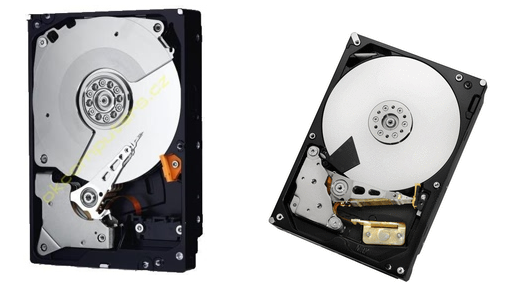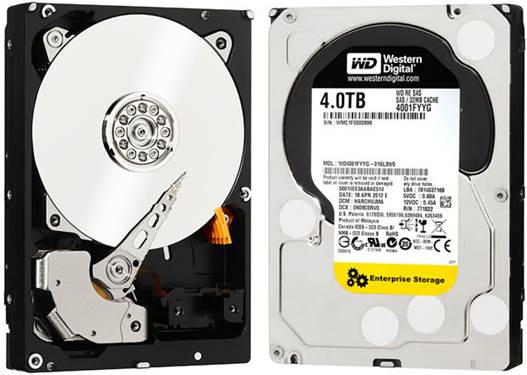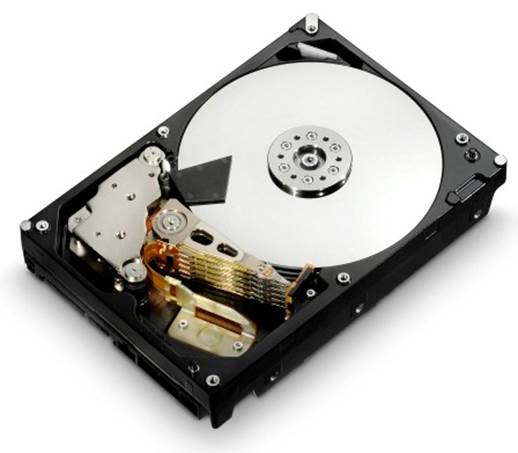Two 4TB drives with 7,200rpm spindles
go platter to platter
Hardcore PC performance fanatics are rarely
satisfied. For example, when we were first given 1TB hard drives, we were
excited, but wanted 2TB. Then we got 2TB and wanted 3TB, and so on, until we
had a 4TB drive in the Lab. When that drive finally arrived, rather than
rejoicing, we continued griping because the drive in question was a Hitachi
5K4000, which spins at a lowly 5.400rpm. The capacity was appreciated, but we
wanted a drive with 4T8 of capacity and a 7.200rpm spindle speed (we actually
want a 4TB SSO, but that’s beside the point. Now the griping shall cease (for
the most part), as we finally have 4TB 7.200rpm drives from Hitachi and WD.
These fine specimens are the fastest and largest drives of their kind, so if
you’re a data hoarder with a need for speed, one of these drives belongs in
your rig.

Western
Digital Re 4TB and Hitachi Ultrastar 7k4000 4TB
Western Digital Re 4TB
The WD RE 4TB drive is specifically meant
to handle an enterprise workload, but don’t (et that scare you off, as it
includes a desktop friendly SATA 6Gb/s interface. As long as you’re running
Windows Vista or Windows 7, you should be able to format it into one partition
somewhat easily, though you could use it as a boot drive if you’re in sane. Its
enterprise pedigree is evident not only in its RE branding but in its 1.2
million-hour MTBF, or mean time between failure. This means you should be using
this drive at (east until Apple Maps for iOS has caught up to Google Maps.
Though we appreciate the nod to reliability
and certainty abhor flaky hard drives, our primary concern in storage affairs
is speed. WD designed the RE 4TB to offer the highest specs possible for a
drive of this type, filing it with a large 64MB buffer and five 800GB platters.
Now, this isn’t a perfect scenario we’d prefer a drive with 1TB platters, as is
the case with some 3TB drives, such as the Seagate Barracuda 3TB, but right now
if you want 4TB and 7,200rpm you get five-platters, so make your peace with it.
In terms of real-world performance, you
won’t miss that extra platter too much, as this 4TB drive is just a bit slower
than the 3TB Barracuda but also slightly faster than several of its 3TB
competitors. In sequential-read tests, we saw the WD drive run neck-and-neck
with its Hitachi counterpart, with both of them averaging 132MB/s, while the
1TB-per-platter Seagate averaged 155MB/s. The WD Caviar Green 3TB can’t hold a
candle to these speeds, though, and neither can the 5,400rpm 4TB Hitachi
5K4000, which is not surprising.

Western
Digital Re 4tb
Our current Adobe Premiere encoding test
writes a 20GB raw AVI file to the drive being tested. The WO RE ran right
alongside SSDs in this test, which means our test is past its prime and is
gated by CPU and application performance these days. However, it was a tad faster
than the Hitachi drive in this test despite their similar write speeds. In our
real-world PCMark Vantage hard drive test, the WO RE 4TB placed third overall
compared to other 3- and 4TB drives. Its performance makes it one of the
fastest high-capacity drives we’ve tested and the fastest 4TB model we’ve seen
thus far.
So it’s fast, and it’s huge. That must mean
the price is equally massive, right? Yes, that is correct’ It is hugely
expensive at $660, which seems ludicrous. That will be a deal-breaker for many,
plain and simple. A data center manager looking to reduce the storage footprint
by 33 percent may see value here, but the average desktop user is better served
with smaller drives. You can buy 2TB drives for roughly $110. so if you’re just
looking for fast storage, they’ll work just fine. If you need maximum capacity
per SATA port, we have no problem recommending the WD RE 4TB, but like any new
technology, it’s prohibitively expensive at this time.
Hitachi Ultrastar 7k4000 4TB
The Hitachi Ultrastar 7k4000 4TB made its
first appearance in this magazine back in September 2012, when a gaggle of them
debuted in the Dream Machine. At the time, they were the only 7,200 rpm 4TB
drives available, so they fit right in among all the other expensive and hard to
find components. Now that the dust has settled and the 7K4000 has some company,
we decided to put it on the test bench to see how it fares against its only
rival in the 4TB category.

Hitachi
Ultrastar 7k4000 4TB
Examining the spec sheet, we see the Hitachi
is a spitting image of its WD nemesis, and since WO owns the Hitachi storage
division now, you would be forgiven for thinking the Hitachi drive is a
rebadged WO model. As far as we can tell, however, the drives are physically
different. Despite this, both share the same overall design, with five 800GB
platters spinning at 7.200rpm, and both have a 64MB buffer as well as a SATA
6Gb/s interface. One area in which the Hitachi has a major advantage is MTBF it’s
rated at 2 million hours, which is almost double the 1.2 million hours offered
by the WO drive and among the highest MTBF drives available today.
Moving along to benchmark results, we found
very few surprises here, at least in comparison to the equally equipped WD 4TB
drive. Both drives performed almost exactly the same in our
sequential-read-and-write tests, coming within 1MB/s of each other. We did see
a small difference between the two drives in random access time, which is
strange since they are both 7.200rpm hard drives, but the WO RE drive was more
than 3ms faster in our tests at 12.5ms, while the Hitachi drive averaged a very
predictable 15.9ms. The Hitachi 4TB also placed at the bottom of the heap in
our PCMark Vantage test, with a surprisingly tow score that was equaled by the
5.400rpm version of this drive; a truly puzzling performance indeed.
So the drive is a bit slower than the WD RE
4TB, and street pricing puts it at $530, which makes the WD almost seem
affordable. Slightly Less performance for more money is never a good equation,
so if you simply must get a 4TB drive, go with the WD RE 4TB. otherwise, as we
stated earlier, stick with less expensive 2 and 3TB drives for now.